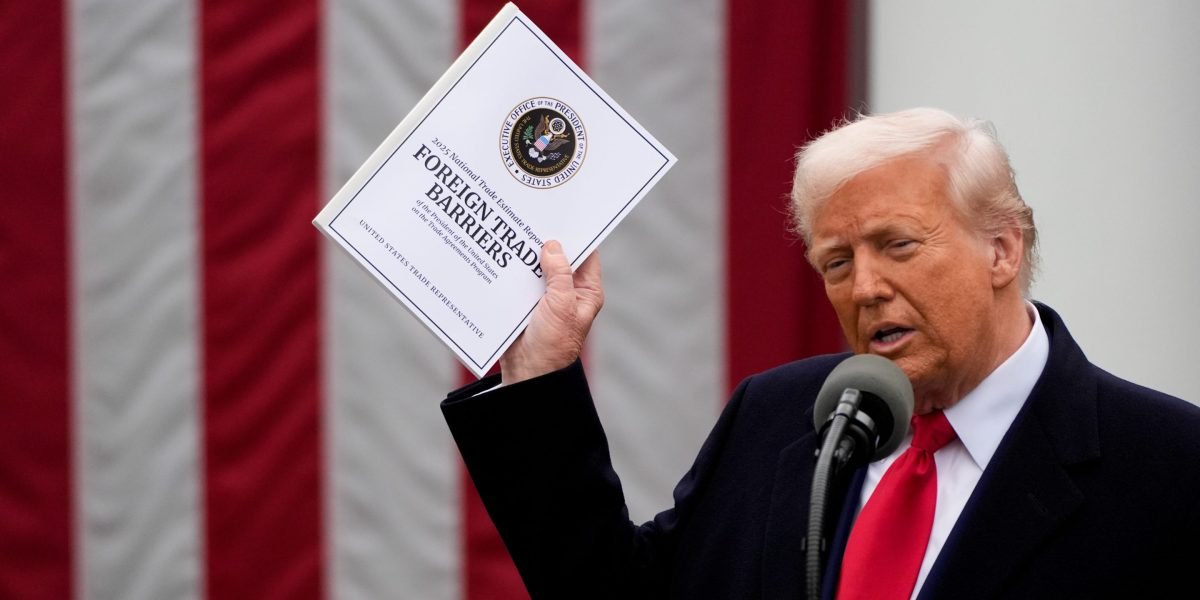

- A conservative think tank found the White House measured retail price elasticity when it should have used import price elasticity. That mistake meant the tariff outputs were about four times higher than they should have been.
The formula the White House used to calculate its recent tariff is based on an error that roughly quadrupled the rates from what they should have been.
Two scholars at the American Enterprise Institute (AEI), a conservative think tank, found the White House used the wrong value when assessing the rate at which prices would change as a result of tariffs. The correct version of the formula uses price changes in the cost of imports, meaning how much it costs a U.S. based company to buy a good from a foreign seller. Instead, the White House factored in the retail price change, which is what consumers pay.
That meant the formula was off by a factor of four, because the White House valued the elasticity of import prices at 0.25 when it should have been 0.945, according to AEI.
“It’s pretty bush league,” Stan Veuger, one of the AEI fellows, told Fortune in phone call. “For such a big policy you’d expect a much higher level of professionalism.”
Using the wrong value rendered the formula inaccurate, according to Veuger and his coauthor Kevin Corinth.
“Now, our view is that the formula the administration relied on has no foundation in either economic theory or trade law,” Corinth and Veuger wrote. “But if we are going to pretend that it is a sound basis for U.S. trade policy, we should at least be allowed to expect that the relevant White House officials do their calculations carefully.”
Another AEI economist, Derek Scissors, went even further, saying the administration hadn’t made a mistake, so much as intentionally fudged the math to get the outcome they wanted.
“This whole thing was rigged,” Scissors said Monday on CNBC. “It was a manipulated way to get very high tariffs because President Trump wanted to announce very high tariffs.”
In their original report Corinth and Veuger said they hoped the White House would lower its tariff rates as a result of their discovery. “Hopefully they will correct their mistake soon: the resulting trade liberalization would provide a much-needed boost to the economy and may yet help us stave off a recession,” they wrote.
The three trading days since President Donald Trump announced the U.S.’s new tariff regime saw markets across the world tank. In the U.S., the Dow Jones, S&P 500, and NASDAQ Composite all cratered. In Asia, stocks in Japan and Hong Kong sank even further on Monday, after Trump vowed to escalate the ongoing trade war. While in Europe stocks fell roughly 4.5% on Monday, after a dismal performance last week.
The calculations used by the White House were already somewhat controversial after it became apparent that discounted “reciprocal tariff” amounts were based on a simple formula of dividing the U.S.’s trade deficit with a foreign country by that country’s total exports to the U.S. The resulting number was then divided by two and used as the tariff rate for said country.
Even without the error, the formula was dubious, Corinth and Stan Veuger said. The formula “does not make economic sense,” they wrote. “The trade deficit with a given country is not determined only by tariffs and non-tariff trade barriers, but also by international capital flows, supply chains, comparative advantage, geography, etc.”
Given that the Trump administration’s tariffs were billed as reciprocal tariffs, analysts and investors had expected they would be based on a careful examination of a country’s trade and non-trade barriers with respect to American-made goods. Instead they were based on the formula, which the Washington Post reports President Donald Trump personally insisted on using.
Trump’s personal views on tariffs were, in Veuger’s view, the principal reason for the recent tariff policy.
“What’s driving the policy, is that since the 1980s Trump has been a protectionist, and he thinks trade deficits are losses and trade surpluses are profits,” Veuger said. “He just likes tariffs. Then you can backfill them with various a little more sophisticated, intellectualized rationalizations. But that’s what it is—it’s rationalization.”
The White House said using retail prices instead of import prices was warranted because consumers make purchasing decisions based on retail rather than wholesale prices. A spokesperson added that in their view the tariff rates should actually have been larger.
Corinth and Veuger pointed to research from Harvard Business School professor Alberto Cavallo cited in the U.S. trade representative’s (USTR) memo about how the tariff formula, as evidence the calculations misinterpreted the difference between retail prices and import prices. Cavallo’s work “makes this distinction clear,” they wrote.
Cavallo himself also addressed the fact his work was referenced in the USTR’s report.
“It is not entirely clear how they use our findings,” Cavallo wrote on X last week. “Based on our research, the elasticity of import prices with respect to tariffs is closer to 1. If that figure were used instead of 0.25, the implied reciprocal tariffs would come out about four times smaller.”
If that version of the formula were adopted it would drastically lower the tariff rates imposed on countries. For example Cambodia’s 49% rate, would drop down to 13% and Vietnam’s would go from 46% to 12.2%. The vast majority of countries would end up being subject to the 10% tariff minimum the White House that is part of the White House’s new policy.
This story was originally featured on Fortune.com
Source link




